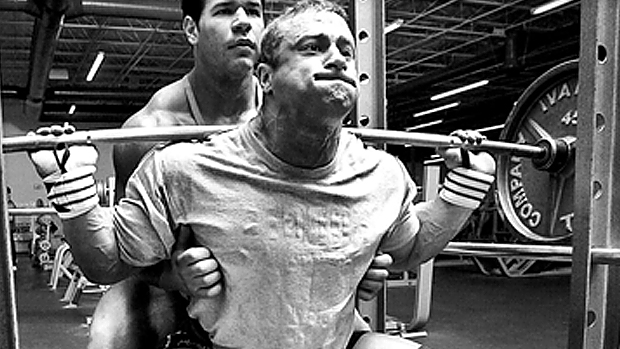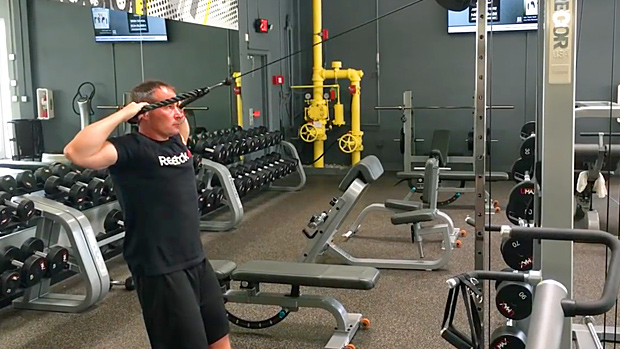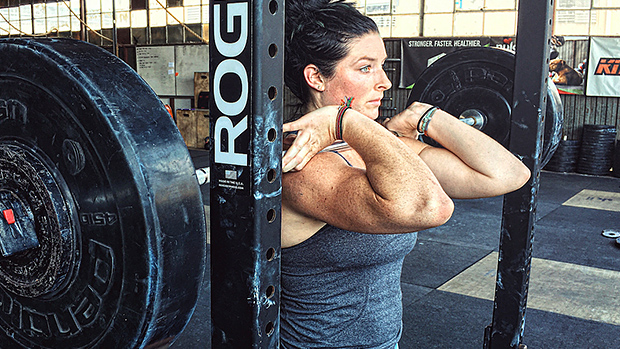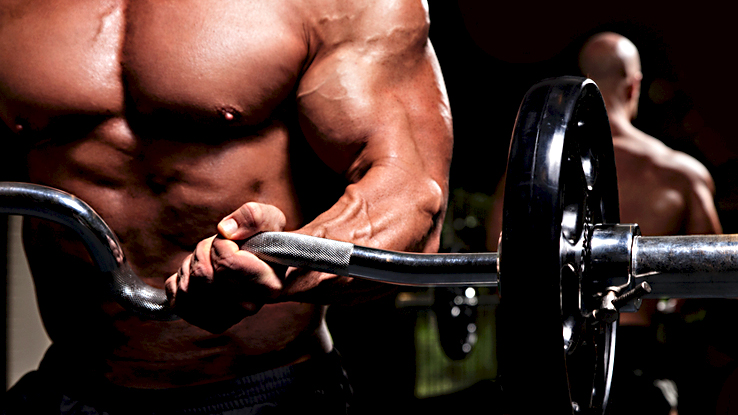Supersets can help you gain more muscle in less time, but only if you know how to pair the perfect exercises.
I've come to realize that over the past ten years, I've gotten a little spoiled. Of course, there are a variety of reasons: T NATION readers are some of the more educated weight-training consumers on the 'Net; I've been around Division 1 athletes who have four years of strength and conditioning continuity in their lives; I've lifted alongside world-class powerlifters; I have a host of athletes who are completely "indoctrinated" with my training philosophies, as it's the only thing they've ever known.
Yeah, I guess you could say that I've become a bit of a lifting snob; I'm always surrounded by people who know how to interpret my programs, leaving me to just program, coach technique, help select weights, and turn up the volume on the stereo.
I realized I was in Fantasyland, though, when my second book, Maximum Strength, was published in June of 2008. This book, which had a bit more "mass market" flavor than the overwhelming majority of my work, was being sold online and in bookstores from Idaho to Thailand, and many of the people buying it were Average Joes who didn't know how to interpret the programs I'd written. One question I received sticks out in my mind:
"I see the "A1 and A2" / "B1 and B2" designations, but am not sure I understand if I'm supposed to alternate the exercises that day (for example, do a set of one-arm DB push press and then do a set of close-grip chin-up and cycle through to complete 3 sets each) or am I supposed to pick one exercise for week 1 and then choose the other exercise in week 2?"
The answer, as the overwhelming majority of T NATION readers knows, is that A1 and A2 indicates a superset. You go back and forth between the two (in all weeks), and once you've completed A1 and A2, you move on to B1 and B2, then C1 and C2, and so on. So, you do all the exercises in all the weeks.
The idea is pretty simple: you're making your training more efficient. So, rather than doing a set of bench presses and then standing around for two minutes before the next set, you superset the bench presses with a variation of rows or a flexibility exercise, for instance. You increase training density and can use the pairings to bring up weak areas.
We know supersets work; in fact, it might be one of the few things that the overwhelming majority of strength coaches and personal trainers agree on!
However, a lot of guys make poor choices (yes, even you). For instance, you'll often see people pairing walking dumbbell lunges and chin-ups, both of which are pretty grip-intensive. As such, I thought it'd be a good time to share some of my favorite supersets so you can use them in your programs immediately.
1. The Regular Ol' Push-Pull Superset

This is probably where we've come to recognize the value of supersets more than anywhere else. Do a set of presses, and instead of just waiting 2-3 minutes to go back to another set of presses, we go to a pull in the middle of the rest period. Let's look at what this works out to over the course of five sets, assuming a two-minute rest between sets and a set duration of thirty seconds:
Option A — Just press 'n wait
30s set
120s rest
30s set
120s rest
30s set
120s rest
30s set
120s rest
30s set
Total Time: 10 minutes, 30 seconds
Option B — Pairing a press and a pull with a "moderate" rest between push and pull
30s set (press)
60s rest
30s set (pull)
60s rest
30s set (press)
60s rest
30s set (pull)
60s rest
30s set (press)
60s rest
30s set (pull)
60s rest
30s set (press)
60s rest
30s set (pull)
60s rest
30s set (press)
60s rest
30s set (pull)
Total Time: 14 minutes
Effectively, you've doubled your training density while only investing 33% more time. And, if you cut the rest intervals down to 45s between the end of a press set and the start of the pull set, you actually keep the rest between sets of presses the same as you did in Option 1 and your total time will be down to 11 minutes, 45 seconds. You don't have to be an economist—or even a graduate of the 6th grade—to know that this is a wise training investment. "More work in less time" holds merit in lifting heavy stuff just like it does in the business world.
The logical next question is, of course, what kind of "pushes" and "pulls?" It's a pretty easy division to make, via four categories:
1. Vertical Push (overhead pressing)
2. Vertical Pull (chin-up/pull-up variations, lat pulldowns)
3. Horizontal Push (bench press and push-up variations)
4. Horizontal (rowing variations)
Pair the vertical pushes with the vertical pulls, and horizontal pushes with the horizontal pulls. And, if you're feeling frisky, you can pair horizontal pushes with vertical pulls, or horizontal pulls with vertical pushes. Your imagination is the only limit.
A word of advice: you'll never get completely perfect antagonist relationships. For example, the long head of the triceps is going to be at least somewhat active in every one of these variations because it's both a shoulder extensor (pull-ups and rows) and an elbow extensor (all presses).
The long head of the biceps flexes both the shoulder (all presses) and elbow (pull-ups and rows) on top of contributing to shoulder joint stability in all tasks. Your rotator cuff is going crazy in all these movements. In short, consider gross movement schemes and try to avoid blatantly obvious overlap in muscle recruitment. But don't get bogged down in minutia when selecting your pairings.
2. The "True Mark of Your Common Sense" Superset
A1) Deadlift variation
A2) Heavy panting!
I throw this in here simply because I want people to realize that not everything in your training needs to be supersetted with another exercise. Sometimes standing around—or at the very most, doing an unrelated stretch or easy mobilization—is exactly what you want. I once heard about a trainer who supersetted back squats with stiff-leg deadlifts. This less-than-enlightened trainer overlooked the fact that:
a) Both exercises heavily tax the posterior chain
b) Both movements absolutely destroy you which, you know, just might compromise technique
c) Intervertebral discs—and not just muscles and the nervous system—are relaxing between sets, too
There are, however, a few ways to make the downtime between deadlift sets more productive.
3. The Stiff Ankle Superset
A1) Deadlift variation
A2) Ankle Mobilization
We do all our deadlifting variations without shoes at Cressey Performance, as this allows athletes to keep the weight on the heels to better activate the posterior chain. It also brings the lifter closer to the ground, so hip mobility deficits can't interfere with getting down to the bar without a rounded back.
Being shoeless also lends itself well to working on some ankle mobility, as being in sneakers typically gives us a false sense of good range of motion at this joint. Wall ankle mobilizations are one option. Here, the goal is to keep the heel down while going into dorsiflexion (knee over toe); don't allow the knee to deviate inward, though.
4. The Front Squat/Vertical Pull Superset
It's a bit easier to superset squats with other movements than deadlifts, but only in specific cases like this:
A1) Front Squat Variation
A2) Vertical Pull Variation
The lats are anatomically less effective as spinal stabilizers during the front squat, which accounts for some of the discrepancy between one's front squat and back squat. If we're not using them as much in stabilization for the front squat, we might as well use them for actually generating movement.
For variation, you can squat to various depths, from pins or a box, or against bands/chains. With the vertical pull, you have several grip choices (neutral/supinated/pronated/alternate, plus different grip widths).
As you get stronger and stronger, though, pairing anything with a squat can get to be a pain in the butt. With that in mind, one substitute we've used is pairing reverse lunges with a front squat grip with any of the vertical pulling variations, and just extended the rest time a bit.
You can also use any lunge variation that uses a bar (dumbbells won't work because of the grip challenge). We use the giant cambered bar a lot.
5. The Unilateral Superset
I get quite a few questions about how to plug single-leg exercises into supersets.
A1) Single-leg Exercise — side #1
A2) Single-leg Exercise — side #2
I structure programs this way because I want people to rest between sides on these movements. Grips falter, scapular stabilizers get fatigued, and there's always a bit of overlap from side to side on these movements. As such, I like to shoot for 30-45 seconds between sides, during which time people can regroup and focus on the quality of the next set instead of rushing right into it.
That said, we generally pair our lower-body work with some kind of core stability or mobility drill. So, I guess it would technically be treated like a triset (or quad-set, if one of these drills is performed on each side).
6. The "Miserable Lower Body Experience" Superset
As I noted above, one of the problems I see with a ton of lower body supersets is that they combine complex exercises like squats and deadlifts with other fatiguing exercises and as a result, the squat and/or deadlift form becomes absolutely atrocious and potentially injurious. From my perspective, effective lower body pairings are safe, but sufficiently compound and functional enough to activate enough muscle mass and have some functional carryover to the real world.
I know most of you won't have a sled or a glute-ham raise at your disposal, but I'm throwing this out there anyway, as it makes for a great finisher at the end of a lower body day:
A1) Reverse Sled Drags
A2) Glute-Ham Raises
The reverse sled drags are about as quad dominant as you can go, and the glute-ham raises crush the posterior chain.
Don't have a sled or glute-ham raise set-up? All you'll need are a bench, a lat pulldown or seated calf raise, a pair of balls, and a good stomach. That way you can pair DB Bulgarian split squats with natural glute-ham raises. For the latter, just set up in reverse and lock your ankles under the pads, controlling yourself down slowly and (most likely) giving yourself a push off with your arms to get back to the top.
7. The "Tony Gentilcore is a Royal A**hole" Superset

Our entire staff trains together at Cressey Performance. Usually, we take one general program and modify it individually to suit our needs. Recently, it was Tony Gentilcore's turn to write up the monthly program, and our first superset on a Thursday lift was as follows:
A1) Bench Press Clusters: 4 x (4x2) — 10s
A2) Farmer's Walk: 4x80yds, going as far as you can on the last set
For those of you who aren't familiar with clusters, for 4 x (4x2) — 10s, this would be four total clusters. Each cluster consists of 4 sets of 2 reps with 10 seconds rest between sets. The idea is that by putting these "mini-rests" between sets of 2, you can use a heavier weight for your sets than if you'd just done eight straight reps. So, training is more dense. All told, you might wind up doing 32 reps with as much as 85% of your 1-rep max.
After the cluster, of course, we went to A2, nearly vomited, and then came back to do another cluster. There was a 25% attrition rate after the second round, and the remaining three of us made it through all four, but couldn't lift our arms for about three days without yelping like a chihuahua giving birth.
To the naked eye (and stomach), this would just seem like torture, but whether he recognized it or not, Tony was on to something. Bench presses are a push and require some lower trap activation for a good "tucked" upper body positioning. Farmer's walks are more of a pull and rely heavily on the upper traps. Lower traps depress the scapula, and upper traps elevate it. Smart move.
I still hated him for it, though.
Supersetting My Closing Thoughts
A1) Your imagination is the limit to designing your own supersets. Just stick to the basics and don't get cute.
A2) Remember that good pairings are both safe and appropriate in light of your goals (e.g., not pairing two grip intensive exercises).
B1) Don't forget that there is absolutely a time and place for rest, and it's usually better to "casually alternate" between sets, as opposed to racing back and forth.
B2) Just because I am showing you a way to make your training more dense and efficient does not mean that you should go ahead and start doing 50 sets per training session just so that you can continue to spend three hours in the gym. Keep it short and sweet.
C1) Good luck.
C2) Thanks for reading.





